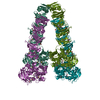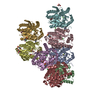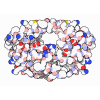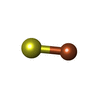+ Open data
Open data
- Basic information
Basic information
| Entry | Database: EMDB / ID: EMD-10540 | |||||||||
|---|---|---|---|---|---|---|---|---|---|---|
| Title | Human polymerase delta-FEN1-PCNA toolbelt | |||||||||
 Map data Map data | ||||||||||
 Sample Sample |
| |||||||||
 Keywords Keywords | Protein / REPLICATION | |||||||||
| Function / homology |  Function and homology information Function and homology informationdelta DNA polymerase complex / DNA synthesis involved in UV-damage excision repair / flap endonuclease activity / zeta DNA polymerase complex / nucleotide-excision repair complex / telomere maintenance via semi-conservative replication / positive regulation of sister chromatid cohesion / double-stranded DNA exodeoxyribonuclease activity / Cytosolic iron-sulfur cluster assembly / positive regulation of deoxyribonuclease activity ...delta DNA polymerase complex / DNA synthesis involved in UV-damage excision repair / flap endonuclease activity / zeta DNA polymerase complex / nucleotide-excision repair complex / telomere maintenance via semi-conservative replication / positive regulation of sister chromatid cohesion / double-stranded DNA exodeoxyribonuclease activity / Cytosolic iron-sulfur cluster assembly / positive regulation of deoxyribonuclease activity / dinucleotide insertion or deletion binding / PCNA-p21 complex / mitotic telomere maintenance via semi-conservative replication / 5'-flap endonuclease activity / purine-specific mismatch base pair DNA N-glycosylase activity / nucleotide-excision repair, DNA gap filling / 3'-5'-DNA exonuclease activity / nuclear lamina / positive regulation of DNA-directed DNA polymerase activity / Polymerase switching / MutLalpha complex binding / Telomere C-strand (Lagging Strand) Synthesis / Processive synthesis on the lagging strand / DNA replication proofreading / PCNA complex / UV protection / DNA replication, removal of RNA primer / Removal of the Flap Intermediate / HDR through MMEJ (alt-NHEJ) / Processive synthesis on the C-strand of the telomere / Polymerase switching on the C-strand of the telomere / Mismatch repair (MMR) directed by MSH2:MSH3 (MutSbeta) / Mismatch repair (MMR) directed by MSH2:MSH6 (MutSalpha) / Transcription of E2F targets under negative control by DREAM complex / Removal of the Flap Intermediate from the C-strand / replisome / response to L-glutamate / 5'-3' exonuclease activity / Hydrolases; Acting on ester bonds; Exodeoxyribonucleases producing 5'-phosphomonoesters / aggresome / exonuclease activity / DNA biosynthetic process / error-free translesion synthesis / DNA strand elongation involved in DNA replication / response to dexamethasone / DNA synthesis involved in DNA repair / histone acetyltransferase binding / DNA polymerase processivity factor activity / G1/S-Specific Transcription / leading strand elongation / Early Phase of HIV Life Cycle / nuclear replication fork / replication fork processing / SUMOylation of DNA replication proteins / POLB-Dependent Long Patch Base Excision Repair / PCNA-Dependent Long Patch Base Excision Repair / fatty acid homeostasis / error-prone translesion synthesis / response to cadmium ion / translesion synthesis / estrous cycle / mismatch repair / response to UV / cyclin-dependent protein kinase holoenzyme complex / base-excision repair, gap-filling / DNA polymerase binding / positive regulation of endothelial cell proliferation / liver regeneration / epithelial cell differentiation / positive regulation of DNA repair / TP53 Regulates Transcription of Genes Involved in G2 Cell Cycle Arrest / Translesion synthesis by REV1 / Translesion synthesis by POLK / Translesion synthesis by POLI / positive regulation of DNA replication / Gap-filling DNA repair synthesis and ligation in GG-NER / replication fork / nuclear estrogen receptor binding / male germ cell nucleus / Termination of translesion DNA synthesis / Recognition of DNA damage by PCNA-containing replication complex / Translesion Synthesis by POLH / double-strand break repair via homologous recombination / receptor tyrosine kinase binding / HDR through Homologous Recombination (HRR) / Dual Incision in GG-NER / DNA-templated DNA replication / memory / cellular response to xenobiotic stimulus / cellular response to hydrogen peroxide / Dual incision in TC-NER / RNA-DNA hybrid ribonuclease activity / Gap-filling DNA repair synthesis and ligation in TC-NER / cellular response to UV / response to estradiol / double-strand break repair / manganese ion binding / E3 ubiquitin ligases ubiquitinate target proteins / heart development / 4 iron, 4 sulfur cluster binding Similarity search - Function | |||||||||
| Biological species |  Homo sapiens (human) / synthetic construct (others) Homo sapiens (human) / synthetic construct (others) | |||||||||
| Method | single particle reconstruction / cryo EM / Resolution: 4.05 Å | |||||||||
 Authors Authors | Lancey C / Hamdan SM | |||||||||
| Funding support |  United Kingdom, 1 items United Kingdom, 1 items
| |||||||||
 Citation Citation |  Journal: Nat Commun / Year: 2020 Journal: Nat Commun / Year: 2020Title: Structure of the processive human Pol δ holoenzyme. Authors: Claudia Lancey / Muhammad Tehseen / Vlad-Stefan Raducanu / Fahad Rashid / Nekane Merino / Timothy J Ragan / Christos G Savva / Manal S Zaher / Afnan Shirbini / Francisco J Blanco / Samir M ...Authors: Claudia Lancey / Muhammad Tehseen / Vlad-Stefan Raducanu / Fahad Rashid / Nekane Merino / Timothy J Ragan / Christos G Savva / Manal S Zaher / Afnan Shirbini / Francisco J Blanco / Samir M Hamdan / Alfredo De Biasio /    Abstract: In eukaryotes, DNA polymerase δ (Pol δ) bound to the proliferating cell nuclear antigen (PCNA) replicates the lagging strand and cooperates with flap endonuclease 1 (FEN1) to process the Okazaki ...In eukaryotes, DNA polymerase δ (Pol δ) bound to the proliferating cell nuclear antigen (PCNA) replicates the lagging strand and cooperates with flap endonuclease 1 (FEN1) to process the Okazaki fragments for their ligation. We present the high-resolution cryo-EM structure of the human processive Pol δ-DNA-PCNA complex in the absence and presence of FEN1. Pol δ is anchored to one of the three PCNA monomers through the C-terminal domain of the catalytic subunit. The catalytic core sits on top of PCNA in an open configuration while the regulatory subunits project laterally. This arrangement allows PCNA to thread and stabilize the DNA exiting the catalytic cleft and recruit FEN1 to one unoccupied monomer in a toolbelt fashion. Alternative holoenzyme conformations reveal important functional interactions that maintain PCNA orientation during synthesis. This work sheds light on the structural basis of Pol δ's activity in replicating the human genome. | |||||||||
| History |
|
- Structure visualization
Structure visualization
| Movie |
 Movie viewer Movie viewer |
|---|---|
| Structure viewer | EM map:  SurfView SurfView Molmil Molmil Jmol/JSmol Jmol/JSmol |
| Supplemental images |
- Downloads & links
Downloads & links
-EMDB archive
| Map data |  emd_10540.map.gz emd_10540.map.gz | 17.4 MB |  EMDB map data format EMDB map data format | |
|---|---|---|---|---|
| Header (meta data) |  emd-10540-v30.xml emd-10540-v30.xml emd-10540.xml emd-10540.xml | 27.3 KB 27.3 KB | Display Display |  EMDB header EMDB header |
| FSC (resolution estimation) |  emd_10540_fsc.xml emd_10540_fsc.xml | 14.3 KB | Display |  FSC data file FSC data file |
| Images |  emd_10540.png emd_10540.png | 68.1 KB | ||
| Filedesc metadata |  emd-10540.cif.gz emd-10540.cif.gz | 8.7 KB | ||
| Archive directory |  http://ftp.pdbj.org/pub/emdb/structures/EMD-10540 http://ftp.pdbj.org/pub/emdb/structures/EMD-10540 ftp://ftp.pdbj.org/pub/emdb/structures/EMD-10540 ftp://ftp.pdbj.org/pub/emdb/structures/EMD-10540 | HTTPS FTP |
-Validation report
| Summary document |  emd_10540_validation.pdf.gz emd_10540_validation.pdf.gz | 393.1 KB | Display |  EMDB validaton report EMDB validaton report |
|---|---|---|---|---|
| Full document |  emd_10540_full_validation.pdf.gz emd_10540_full_validation.pdf.gz | 392.6 KB | Display | |
| Data in XML |  emd_10540_validation.xml.gz emd_10540_validation.xml.gz | 13.4 KB | Display | |
| Data in CIF |  emd_10540_validation.cif.gz emd_10540_validation.cif.gz | 18.3 KB | Display | |
| Arichive directory |  https://ftp.pdbj.org/pub/emdb/validation_reports/EMD-10540 https://ftp.pdbj.org/pub/emdb/validation_reports/EMD-10540 ftp://ftp.pdbj.org/pub/emdb/validation_reports/EMD-10540 ftp://ftp.pdbj.org/pub/emdb/validation_reports/EMD-10540 | HTTPS FTP |
-Related structure data
| Related structure data |  6tnzMC  6s1mC  6s1nC  6s1oC  6tnyC C: citing same article ( M: atomic model generated by this map |
|---|---|
| Similar structure data | |
| EM raw data |  EMPIAR-10823 (Title: Cryo electron micrographs of Pol delta-PCNA-DNA-FEN1 sample EMPIAR-10823 (Title: Cryo electron micrographs of Pol delta-PCNA-DNA-FEN1 sampleData size: 1.6 TB Data #1: Cryo-electron micrographs of Pol delta-FEN1 toolbelt [micrographs - multiframe]) |
- Links
Links
| EMDB pages |  EMDB (EBI/PDBe) / EMDB (EBI/PDBe) /  EMDataResource EMDataResource |
|---|---|
| Related items in Molecule of the Month |
- Map
Map
| File |  Download / File: emd_10540.map.gz / Format: CCP4 / Size: 244.1 MB / Type: IMAGE STORED AS FLOATING POINT NUMBER (4 BYTES) Download / File: emd_10540.map.gz / Format: CCP4 / Size: 244.1 MB / Type: IMAGE STORED AS FLOATING POINT NUMBER (4 BYTES) | ||||||||||||||||||||||||||||||||||||||||||||||||||||||||||||
|---|---|---|---|---|---|---|---|---|---|---|---|---|---|---|---|---|---|---|---|---|---|---|---|---|---|---|---|---|---|---|---|---|---|---|---|---|---|---|---|---|---|---|---|---|---|---|---|---|---|---|---|---|---|---|---|---|---|---|---|---|---|
| Projections & slices | Image control
Images are generated by Spider. | ||||||||||||||||||||||||||||||||||||||||||||||||||||||||||||
| Voxel size | X=Y=Z: 0.87 Å | ||||||||||||||||||||||||||||||||||||||||||||||||||||||||||||
| Density |
| ||||||||||||||||||||||||||||||||||||||||||||||||||||||||||||
| Symmetry | Space group: 1 | ||||||||||||||||||||||||||||||||||||||||||||||||||||||||||||
| Details | EMDB XML:
CCP4 map header:
| ||||||||||||||||||||||||||||||||||||||||||||||||||||||||||||
-Supplemental data
- Sample components
Sample components
+Entire : Toolbelt
+Supramolecule #1: Toolbelt
+Supramolecule #2: DNA polymerase
+Supramolecule #3: Proliferating cell nuclear antigen, flap endonuclease
+Supramolecule #4: DNA primer, template
+Macromolecule #1: DNA polymerase delta catalytic subunit
+Macromolecule #2: DNA polymerase delta subunit 2
+Macromolecule #3: DNA polymerase delta subunit 3
+Macromolecule #4: DNA polymerase delta subunit 4
+Macromolecule #5: Proliferating cell nuclear antigen
+Macromolecule #6: Flap endonuclease 1
+Macromolecule #7: DNA primer
+Macromolecule #8: DNA template
+Macromolecule #9: ZINC ION
+Macromolecule #10: IRON/SULFUR CLUSTER
+Macromolecule #11: THYMIDINE-5'-TRIPHOSPHATE
-Experimental details
-Structure determination
| Method | cryo EM |
|---|---|
 Processing Processing | single particle reconstruction |
| Aggregation state | particle |
- Sample preparation
Sample preparation
| Buffer | pH: 7.5 Component:
| |||||||||||||||||||||
|---|---|---|---|---|---|---|---|---|---|---|---|---|---|---|---|---|---|---|---|---|---|---|
| Grid | Model: Quantifoil, UltrAuFoil, R1.2/1.3 / Material: GOLD / Mesh: 300 / Support film - Material: GRAPHENE OXIDE / Support film - topology: CONTINUOUS / Pretreatment - Type: GLOW DISCHARGE / Pretreatment - Time: 300 sec. | |||||||||||||||||||||
| Vitrification | Cryogen name: ETHANE / Chamber humidity: 100 % / Chamber temperature: 277 K / Instrument: FEI VITROBOT MARK IV | |||||||||||||||||||||
| Details | Complex separated by gel filtration |
- Electron microscopy
Electron microscopy
| Microscope | FEI TITAN KRIOS |
|---|---|
| Temperature | Min: 77.0 K / Max: 77.0 K |
| Specialist optics | Phase plate: OTHER |
| Image recording | Film or detector model: GATAN K3 BIOQUANTUM (6k x 4k) / Digitization - Dimensions - Width: 11520 pixel / Digitization - Dimensions - Height: 8184 pixel / Number grids imaged: 1 / Number real images: 5071 / Average exposure time: 3.0 sec. / Average electron dose: 44.0 e/Å2 / Details: Data were collected in super resolution mode |
| Electron beam | Acceleration voltage: 300 kV / Electron source:  FIELD EMISSION GUN FIELD EMISSION GUN |
| Electron optics | C2 aperture diameter: 50.0 µm / Calibrated magnification: 57471 / Illumination mode: FLOOD BEAM / Imaging mode: BRIGHT FIELD / Cs: 2.7 mm / Nominal defocus max: 2.3000000000000003 µm / Nominal defocus min: 1.1 µm / Nominal magnification: 105000 |
| Sample stage | Specimen holder model: FEI TITAN KRIOS AUTOGRID HOLDER / Cooling holder cryogen: NITROGEN |
| Experimental equipment |  Model: Titan Krios / Image courtesy: FEI Company |
 Movie
Movie Controller
Controller





































 Z (Sec.)
Z (Sec.) Y (Row.)
Y (Row.) X (Col.)
X (Col.)


























